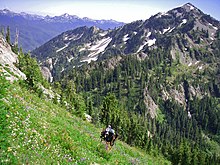geo.wikisort.org - Mountains
Mount Scott is a 5,913-foot (1,802-metre) mountain summit located within Olympic National Park in Jefferson County of Washington state.[3]
| Mount Scott | |
|---|---|
 West aspect | |
| Highest point | |
| Elevation | 5,913 ft (1,802 m)[1] |
| Prominence | 1,173 ft (358 m)[2] |
| Parent peak | Mount Ferry (6,195 ft)[2] |
| Isolation | 1.79 mi (2.88 km)[2] |
| Coordinates | 47°50′28″N 123°31′47″W[3] |
| Naming | |
| Etymology | James Wilmot Scott |
| Geography | |
| Location | Olympic National Park Jefferson County, Washington, US |
| Parent range | Olympic Mountains |
| Topo map | USGS Mount Queets |
| Geology | |
| Age of rock | Eocene |
| Climbing | |
| Easiest route | class 2 scrambling[2] |
Description
Mount Scott is part of the Bailey Range, which is a subrange of the Olympic Mountains, and is set within the Daniel J. Evans Wilderness.[4] The nearest higher neighbor is line parent Mount Ferry, 1.8 mi (2.9 km) to the west, Ludden Peak is set one mile to the north, and Mount Pulitzer rises two miles to the west-southwest.[4] Precipitation runoff from the mountain drains into tributaries of the Goldie River, which in turn is a tributary of the Elwha River. Topographic relief is significant as the summit rises 4,300 feet (1,310 m) above the Elwha Valley in approximately two miles.
Climate

Based on the Köppen climate classification, Mount Scott is located in the marine west coast climate zone of western North America.[5] Most weather fronts originate in the Pacific Ocean, and travel east toward the Olympic Mountains. As fronts approach, they are forced upward by the peaks of the Olympic Range, causing them to drop their moisture in the form of rain or snowfall (Orographic lift). As a result, the Olympics experience high precipitation, especially during the winter months. During winter months, weather is usually cloudy, but due to high pressure systems over the Pacific Ocean that intensify during summer months, there is often little or no cloud cover during the summer.
Geology
The Olympic Mountains are composed of obducted clastic wedge material and oceanic crust, primarily Eocene sandstone, turbidite, and basaltic oceanic crust.[6] The mountains were sculpted during the Pleistocene era by erosion and glaciers advancing and retreating multiple times.
Etymology

This peak was named by the 1889–90 Seattle Press Expedition for James Wilmot Scott (1849–1895), editor and publisher of the Chicago Herald, a newspaper he started in 1881.[7]
This geographical feature's name has been officially adopted by the U.S. Board on Geographic Names.[3]
See also
- Geology of the Pacific Northwest
References
- Olympic Mountain Rescue, Olympic Mountains: A Climbing Guide, 4th Edition, 2006, Mountaineers Books, ISBN 9780898862065, page 193.
- "Scott, Mount - 5,913' WA". listsofjohn.com. Retrieved 2022-01-22.
- "Mount Scott". Geographic Names Information System. United States Geological Survey, United States Department of the Interior. Retrieved 2022-01-22.
- "Mount Scott". Peakbagger.com.
- Peel, M. C.; Finlayson, B. L.; McMahon, T. A. (2007). "Updated world map of the Köppen−Geiger climate classification". Hydrol. Earth Syst. Sci. 11: 1633–1644. ISSN 1027-5606.
- Alt, D.D.; Hyndman, D.W. (1984). Roadside Geology of Washington. pp. 249–259. ISBN 0-87842-160-2.
- Parratt, Smitty (1984). Gods and Goblins: A Field Guide to Place Names of Olympic National Park (1st ed.).
External links
- James Wilmot Scott
- James Wilmot Scott biography
- "Olympic National Park". National Park Service.
Другой контент может иметь иную лицензию. Перед использованием материалов сайта WikiSort.org внимательно изучите правила лицензирования конкретных элементов наполнения сайта.
WikiSort.org - проект по пересортировке и дополнению контента Википедии

